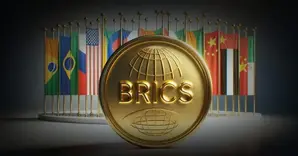A de-dollarization solution is being put into practice by leading organizations right now as global currency shifts pick up speed. The de-dollarization meaning goes beyond just swapping currencies – it actually represents a fundamental way of restructuring how companies handle financial risk. Major firms across countries supporting de-dollarization are deploying sophisticated risk governance frameworks along with currency exposure management systems. These de-dollarization solution approaches use automated systems that can detect currency-related risks even before they start spreading throughout operations.
Also Read: $400B China Fund Launches First Yuan Token in De-Dollarization Push
How Leading Firms Use Governance and Risk Tools for De-Dollarization Success

Currency Mapping and Real-Time Monitoring
Smart companies are mapping every single touchpoint where currency fluctuations might affect their operations right now. This particular de-dollarization solution involves tagging procurement processes, contracts, and also supplier obligations by both currency and geography. Organizations have been creating real-time visibility into areas where currency shifts can impact pricing along with sourcing.
Steven Minsky, CEO of LogicManager, had this to say:
“Many LogicManager customers are already using their ERM programs to do just that. Quietly, they’ve built the operational governance necessary to detect early signals, map dependencies, and ensure risk-based processes adapt automatically as conditions evolve.”
When vendors actually request renegotiations due to exchange rate volatility, automated workflows surface every impacted process immediately. This approach eliminates the need for manual tracking across different departments.
Third-Party Risk and Early Warning Systems
Currency exposure management requires systematic third-party monitoring at the time of writing. Vendor concentration amplifies exposure when suppliers operate in currencies that are under stress. Organizations are flagging situations when single vendors support multiple critical functions across their operations.
The de-dollarization meaning becomes clear through early warning indicators that monitor incremental changes – things like unexpected contract clauses, delayed shipments, and additional conversion fees. Risk governance framework systems define thresholds that trigger automated workflows when conditions actually warrant review.
BRICS Nations and Corporate Response
BRICS countries like Brazil, Russia, India, China, and South Africa are leading current currency shifts right now. Russia has been implementing de-dollarization strategies partly in response to US sanctions. These geopolitical movements create ripple effects that companies are preparing for through risk governance framework approaches.
The currency exposure management strategies being deployed provide early indicators that corporate risk managers incorporate into their monitoring systems. Organizations operating in these de-dollarization countries use systematic de-dollarization solution methods to manage their exposure.
Also Read: Next US Dollar Low: Key Week With Fed Decision and Tariff Risk
Companies don’t actually need new committees or massive projects – they can activate existing governance capabilities that connect risks across business operations for more systematic responses.






